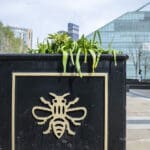SHARE
Why Is The Bee The Symbol Of Manchester?

As you make your way around the Manchester city streets, you might well see a few little bee symbols here, there and everywhere.
They can be seen on rubbish bins, on planters, on the walls of buildings (check out the Royal Insurance building outside the Royal Exchange Theatre in St Ann’s Square), in mosaics on the floor… they’re all over the place!
But have you ever wondered just why there are so many bees buzzing around? What, exactly, is their significance to Mancunians and the wonderful city they call home?
Interestingly, it all stems back to the Industrial Revolution, in which Manchester played a significant role. Considered to be the first industrial city in the world, Manchester is famous for its cotton industry, which enjoyed rapid growth at the start of the 19th century… and you’ll often hear it referred to as Cottonopolis, as a result.
In 1842, early Manchester city fathers had to come up with a good coat of arms that would capture the essence of the township and its particularly strong work ethic, so the bee was an exceptionally good choice.
A globe with seven bees was designed to reflect the city’s trade links around the world, with the insects representing the hive of activity that Manchester became during the Industrial Revolution. This coat of arms can be found all over the city, including on the Town Hall and the Corn Exchange, so keep a look out as you wander around.
But it’s not just the insignia that can be found carved in stone… beehives can now be found in every corner of Manchester, as well, helping to support declining populations and bringing the city even more to life.
There are hives to be found on top of the Cathedral, at Manchester Art Gallery and at the Printworks, to name but a few – and you can even get true-blue Manchester honey to take home as a souvenir. Buzzing!

